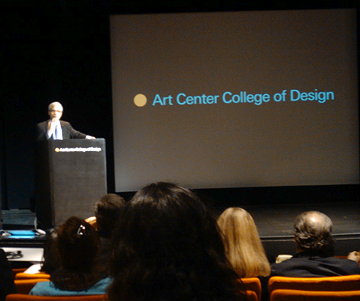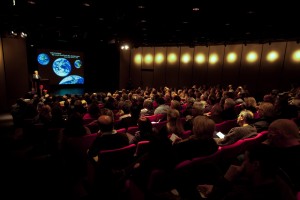
What does the great art and design school of the 21st century look like? How can it best serve its students?
Last year, the Art Center community came together to find out. Through an all-inclusive visioning process, we addressed the challenges of making our distinctive education cutting-edge and pertinent—the what, where and why—and envisioned Art Center’s future.
The result of this process is Art Center’s 2011-2016 strategic plan, unveiled last week to the College community. The five-year plan both honors Art Center’s distinguished 80-year history and imagines its future. It shapes our core values into a new model for art and design education for the 21st century—one that ensures continuing excellence, relevance and impact for decades to come.
We sat down with College president Lorne Buchman to find out more about the strategic plan, how it came about, and what it means to the Art Center community.
Dotted Line: Why was it important to involve the entire Art Center community in the visioning process?
Lorne Buchman: Art Center has a reputation for being incredibly rigorous with our students—it’s key to the quality and the kind of education that we offer. One of the wonderful things about the planning process was that it was a chance for us as an institution to be as rigorous with ourselves as we are with our students.
In coming up with this strategic plan, we felt it was really important that everyone—alumni, students, faculty, staff, Trustees—participate in the planning process that culminated in the plan. The College is filled with brilliant, creative, wonderful people who care deeply about this institution, and who have the power to design their future. The spirit of this planning process proceeded as such.
Dotted Line: And a new College mission statement came out of the process as well?
Buchman: Yes. I’ve never loved a mission statement, but I love this one: “Learn to create. Influence change.” It’s such a profound educational philosophy, and what our College is about.
Dotted Line: Why was a strategic plan necessary?
Buchman: There is a new ecology of learning going on. Higher education is changing incredibly rapidly. Our students are changing—they’re different than they were five, even 10 years ago. We must be attuned and responsive to these things.
Dotted Line: In what ways have students changed?
Buchman: Our students are coming to us with a real kind of social consciousness. I think the success of Designmatters demonstrates this rather well. Students are coming to Art Center with the goal of finding meaningful work after graduation. They understand that what they do as artists and designers has ramifications for all communities and corners of the world. They can lend a way of thinking, creating, solving problems and addressing issues. That’s very deep and profound, and it opens up a new kind of knowledge. It’s our duty to help them in this pursuit.
Dotted Line: One of the plan’s key pillars is the Conservatory Spirit, which isn’t a term one usually applies to an art and design school. Can you elaborate?
Buchman: The idea of Art Center as a conservatory has its roots in the school’s history. This has always been a place that prepares students for creative and career success. Akin to Juilliard, we provide the highest caliber of education, we employ a professional faculty who bring a sense of real-world relevance to the classroom environment and we offer programs that meet the demands of society—all to ensure artists and designers have a place in the world. This is where the conservatory spirit comes from.

 The five-year strategic plan represents the culmination of more than a year of deep conversations, brainstorms and working group sessions with the entire Art Center community—students, faculty, staff, alumni, trustees and friends—that explored the intrinsic qualities of the great art and design college of the future.
The five-year strategic plan represents the culmination of more than a year of deep conversations, brainstorms and working group sessions with the entire Art Center community—students, faculty, staff, alumni, trustees and friends—that explored the intrinsic qualities of the great art and design college of the future. 


